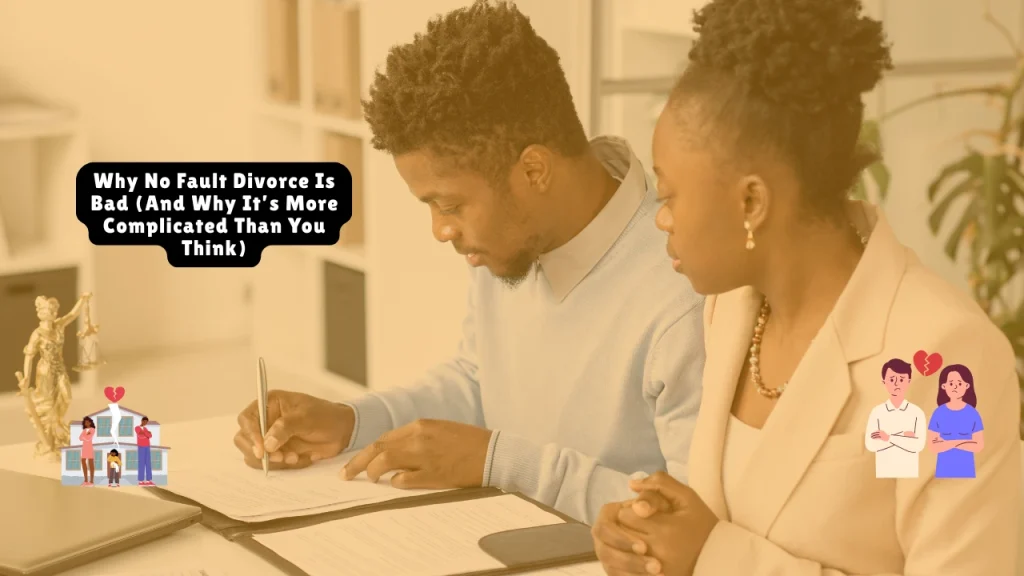Why No Fault Divorce Is Bad (And Why It’s More Complicated Than You Think)
No-fault divorce is considered bad by many critics because it allows one spouse to end a marriage without proving fault—leading to higher divorce rates, emotional trauma, financial disparities, and weaker family structures. Opponents argue it devalues commitment, enables unilateral separation without accountability, and harms children emotionally and academically. However, supporters counter that no-fault divorce protects abuse victims and reduces legal hypocrisy, making divorce safer and less traumatizing for vulnerable individuals. The truth? No-fault divorce brings both freedom and fallout—its flaws call for reform, not reversal.
Table of Contents
No-Fault Divorce: Unpacking the Criticism, Evidence, and the Path Forward
The Rise of No-Fault Divorce: A Revolution Born from Injustice
Before 1970, American divorce law demanded proof of fault—adultery, cruelty, abandonment. This forced spouses to lie, stage infidelity, or endure abuse. California’s 1969 law (signed by then-Gov. Ronald Reagan) introduced “irreconcilable differences” as grounds, triggering a national shift. By 1985, all U.S. states adopted no-fault provisions.
The goal was noble: reduce perjury, legal games, and help victims escape abusive or loveless marriages.
Top Criticisms of No-Fault Divorce
Despite good intentions, critics point to several unintended outcomes:
1. Higher Divorce Rates & Weakened Marriage Culture
Making divorce easier removed key legal barriers, leading to a 25% increase in divorces in the decade following no-fault adoption (Parkman, UNM). Some say it made marriage feel disposable.
Related article: Who Gets the House in Divorce with Children?
2. Children Caught in the Crossfire
Psychologists like Dr. Elizabeth Marquardt argue that children suffer emotional and academic setbacks post-divorce—especially when it’s abrupt or one-sided. No-fault systems often overlook the child’s need for stability and structured transitions.
3. Economic Fallout for Caregivers
The shift to a “50/50 split” in assets may look fair on paper but ignores years of unpaid caregiving. Women—particularly stay-at-home mothers—face higher poverty rates post-divorce. According to U.S. Census data, 20% of divorced women live below the poverty line versus 11% of men.
4. Unilateral Divorce & Lack of Accountability
Under no-fault laws, one spouse can file for divorce without the other’s consent or any wrongdoing. Critics like retired Judge Janice Law argue this eliminates judicial scrutiny and turns divorce into mere “paperwork processing.”
5. No Voice for the “Wronged” Spouse
With no avenue to prove betrayal or abuse, the “left” partner is denied a sense of justice or closure. Reddit testimonials and family court interviews reflect feelings of sudden abandonment and mental trauma.
Related article: Does It Matter Who Files for Divorce First in the US?

What the Data Says: Does No-Fault Help or Hurt?
| Claim | Evidence |
| Divorce Rates Skyrocket | Initial spike post-reform, then declined 40% by 2020 (NCHS) |
| Hurts Women | Female suicides dropped 8–16%; DV dropped 30% after no-fault (Stevenson & Wolfers) |
| Children Do Worse | Divorce is less harmful than constant parental conflict (Amato & Booth, 1996) |
| Financial Instability | More women fall into poverty under no-fault—but fault-based systems also deny asset protection |
Key Insight: The biggest benefits of no-fault divorce are for abuse victims and couples in high-conflict marriages. Still, the economic and emotional costs—especially for the innocent party—remain high and often unaddressed.
Unintended Consequences and Overlooked Complexities
A. Abuse Survivors at Risk
Ironically, no-fault laws can obscure abuse in court. If no evidence is submitted, survivors may lose out on custody or fair settlements. Real-life cases show that financial justice is elusive without fault findings.
B. Shifted Legal Conflict
While fault is gone, conflict hasn’t disappeared—it just moved:
- Child custody (85% of contested cases)
- Asset hiding or spousal support disputes
- Psychological battles over loyalty and fairness
Related article: I Want A Divorce But My Wife Can’t Support Herself, Complete Legal and Financial Guide
C. Socioeconomic Stress > Legal Reform
Divorce rates correlate strongly with:
- Financial strain
- Unemployment
- Declining religious and community support
The legal system is only one piece of the puzzle.
Global Perspectives: No-Fault Isn’t Universal
| Country | Divorce Model | Outcome |
| UK | No-fault with 20-week waiting | Reduces conflict; promotes thoughtful decisions |
| France | Hybrid (fault or consent-based) | Balanced emotional and legal closure |
| Italy | Fault-based only | One of Europe’s lowest divorce rates |
| Philippines | No divorce; only annulment allowed | Divorce is not legal |
Some systems offer mandatory counseling, cooling-off periods, or allow fault in asset division—proposals U.S. critics are now advocating.
Who’s Left Out of the Conversation?
A. Fathers and Custody
Men’s rights groups argue that no-fault laws often bias custody toward mothers, especially without fault evidence. Some fathers report alienation or “paper-parenting” after divorce.
B. LGBTQ+ Couples
Post-Obergefell, same-sex couples rely heavily on no-fault laws for equal access to marriage and divorce. Yet parental rights (especially for non-biological parents) remain legally murky.
C. Stay-at-Home Parents
The debate often ignores that alimony is shrinking. Solutions include:
- Rehabilitative support (for job reentry)
- Penalties for strategic underemployment
- Childcare credits in asset division
Policy Proposals, Reform Without Reversal
Abolishing no-fault laws would trap abuse victims again. But there are smarter middle paths:
Multi-Path Divorce Options:
- Path A: No-fault with 6-month reflection period
- Path B: Fault-based with enhanced financial compensation
- Path C: Child-protection focused (mandatory mediation)
Economic Reforms:
- Presume lifelong support in long marriages (>15 years)
- Use “misconduct multipliers” for provable abuse
- Fund career training for dependent spouses
Prevention & Support:
- Tax credits for pre-marital counseling
- Free mediation for low-income couples
- Legal resources for navigating unilateral divorce
Related article: Is Ohio a No-Fault Divorce State?
Conclusion, Rethinking, Not Repealing No-Fault Divorce
No-fault divorce was born from necessity—to protect the trapped and abused. But it came with a cost: less accountability, sudden breakups, economic unfairness, and overlooked emotional trauma.
The path forward isn’t turning back the clock. It’s about smart reform:
- Support for caregivers
- Protections against coercion
- Legal frameworks that value family, not just individual autonomy
Marriage should be free—but ending it shouldn’t be careless.
If you’re facing a no-fault divorce or family law issue, consult with a qualified family attorney. If you’re a policymaker, advocate for divorce reform that balances freedom with fairness—especially for children and financially dependent spouses.
About the Author

Sarah Klein, JD, is a former family law attorney with over a decade of courtroom and mediation experience. She has represented clients in divorce, custody cases, adoption, Alimony, and domestic violence cases across multiple U.S. jurisdictions.
At All About Lawyer, Sarah now uses her deep legal background to create easy-to-understand guides that help families navigate the legal system with clarity and confidence.
Every article is based on her real-world legal experience and reviewed to reflect current laws.
Read more about Sarah
